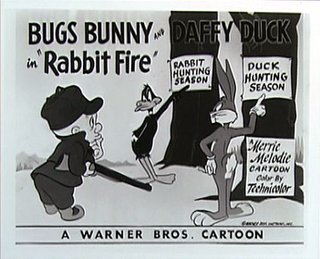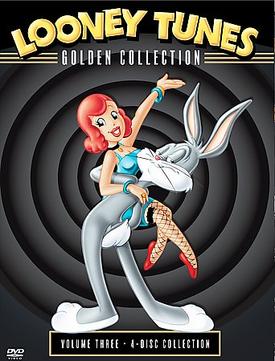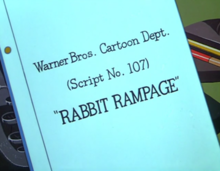
Looney Tunes is an American animated franchise produced and distributed by Warner Bros. It began as a series of short films that originally ran from 1930 to 1969, concurrently with its partner series Merrie Melodies, during the golden age of American animation. Following a revival in the late 1970s, new shorts were released as recently as 2014. The two series introduced a large cast of characters, including Bugs Bunny, Daffy Duck, and Porky Pig. The term Looney Tunes has since been expanded to also refer to the characters themselves.

Duck Amuck is an American animated surreal comedy short film directed by Chuck Jones and written by Michael Maltese. The short was released on January 17, 1953, as part of the Merrie Melodies series, and stars Daffy Duck.

What's Opera, Doc? is a 1957 American Warner Bros. Merrie Melodies cartoon directed by Chuck Jones and written by Michael Maltese. The short was released on July 6, 1957, and stars Bugs Bunny and Elmer Fudd.

Merrie Melodies is an American animated comedy short film series distributed by Warner Bros. Pictures. It is the companion series to Looney Tunes, and featured many of the same characters. It originally ran from August 2, 1931, to September 20, 1969, during the golden age of American animation, though it was revived in 1979, with new shorts sporadically released until June 13, 1997. Originally, Merrie Melodies placed emphasis on one-shot color films in comparison to the black-and-white Looney Tunes films. After Bugs Bunny became the breakout character of Merrie Melodies and Looney Tunes transitioned to color production in the early 1940s, the two series gradually lost their distinctions and shorts were assigned to each series randomly.

Rabbit Fire is a 1951 Looney Tunes cartoon starring Bugs Bunny, Daffy Duck, and Elmer Fudd. Directed by Chuck Jones and written by Michael Maltese, the cartoon is the first in Jones' "hunting trilogy"—the other two cartoons following it being Rabbit Seasoning and Duck! Rabbit, Duck! It is also the first cartoon to feature a feud between Bugs and Daffy. Produced by Edward Selzer for Warner Bros. Cartoons, the short was released to theaters on May 19, 1951 by Warner Bros. Pictures and is often considered among Jones' best and most important films.

Elmer's Candid Camera is a 1940 Warner Bros. Merrie Melodies cartoon short directed by Chuck Jones. The short was released on March 2, 1940, and features Elmer Fudd and an early Bugs Bunny prototype.
Rabbit Seasoning is a 1952 Warner Bros. Merrie Melodies cartoon directed by Chuck Jones. Released on September 20, 1952, the short stars Bugs Bunny, Daffy Duck and Elmer Fudd.

Duck! Rabbit, Duck! is a 1953 Warner Bros. Merrie Melodies cartoon directed by Charles M. Jones. The cartoon was released on October 3, 1953 and stars Bugs Bunny, Daffy Duck and Elmer Fudd.

Looney Tunes Golden Collection: Volume 1 is a DVD box set that was released by Warner Home Video on October 28, 2003. The first release of the Looney Tunes Golden Collection DVD series, it contains 56 Looney Tunes and Merrie Melodies cartoons and numerous supplements. The set won the Classic Award at the Parents' Choice Awards.

A Corny Concerto is a 1943 Warner Bros. Merrie Melodies directed by Bob Clampett. The short was released on September 25, 1943, and stars Bugs Bunny, Porky Pig, Elmer Fudd and Daffy Duck.
Beanstalk Bunny is a 1955 Warner Bros. Merrie Melodies cartoon directed by Chuck Jones. The short was released on February 12, 1955, and stars Bugs Bunny, Daffy Duck and Elmer Fudd. The cartoon's story is derived from the fairy tale "Jack and the Beanstalk".

A Pest in the House is a Merrie Melodies animated short film released on August 2, 1947. It is directed by Chuck Jones and stars the characters of Daffy Duck and Elmer Fudd.

Person to Bunny is a 1960 Merrie Melodies animated cartoon directed by Friz Freleng. The short was released on April 1, 1960, and stars Bugs Bunny, Daffy Duck and Elmer Fudd. It is the last cartoon to feature Arthur Q. Bryan as the voice of Elmer, and was released shortly after Bryan's death.

A Star Is Bored is a 1956 Warner Bros. Looney Tunes cartoon, directed by Friz Freleng. The short was released on September 15, 1956, and stars Bugs Bunny and Daffy Duck. The cartoon expands upon the rivalry depicted between Bugs and Daffy, in such films as Chuck Jones' 1951 short Rabbit Fire, this time placing the action in a show-biz setting. In this 7-minute short, Daffy must double for Bugs in any slapstick that Warners deems too dangerous for its top star. After each disaster, Daffy shouts "MAKEUP!". The director directing the scenes has an Erich Von Stroheim accent.

This Is a Life? is a 1955 Warner Bros. Merrie Melodies animated cartoon directed by Friz Freleng, written by Warren Foster, and produced by Edward Selzer, with music directed by Milt Franklyn. The short was released on July 9, 1955, and stars Bugs Bunny. The voices were performed by Mel Blanc, Arthur Q. Bryan, and June Foray in her first work for Warner Bros. This is one of the few Bugs Bunny cartoons whose title does not contain Bugs, bunny, rabbit/wabbit or hare.

Elmer J. Fudd is an animated cartoon character in the Warner Bros. Looney Tunes/Merrie Melodies series and the archenemy of Bugs Bunny. His aim is to hunt Bugs, but he usually ends up seriously injuring himself and other antagonizing characters. He speaks in an unusual way, replacing his Rs and Ls with Ws, so he often refers to Bugs Bunny as a "scwewy" or "wascawwy (rascally) wabbit". Elmer's signature catchphrase is, "Shhh. Be vewy vewy quiet, I'm hunting wabbits", as well as his trademark laughter.
This is a listing of all theatrical animated shorts released by Warner Bros. under the Looney Tunes and Merrie Melodies banners between 1970 and the present. It also lists shorts originally planned for theatrical release and other shorts that were not feature films, television series, or television specials.

Looney Tunes Golden Collection: Volume 3 is a DVD box set from Warner Home Video that was released on October 25, 2005. It contains 60 Looney Tunes and Merrie Melodies theatrical short subject cartoons, nine documentaries, 32 commentary tracks from animators and historians, 11 "vintage treasures from the vault", and 11 music-only or music-and-sound-effects audio tracks.















